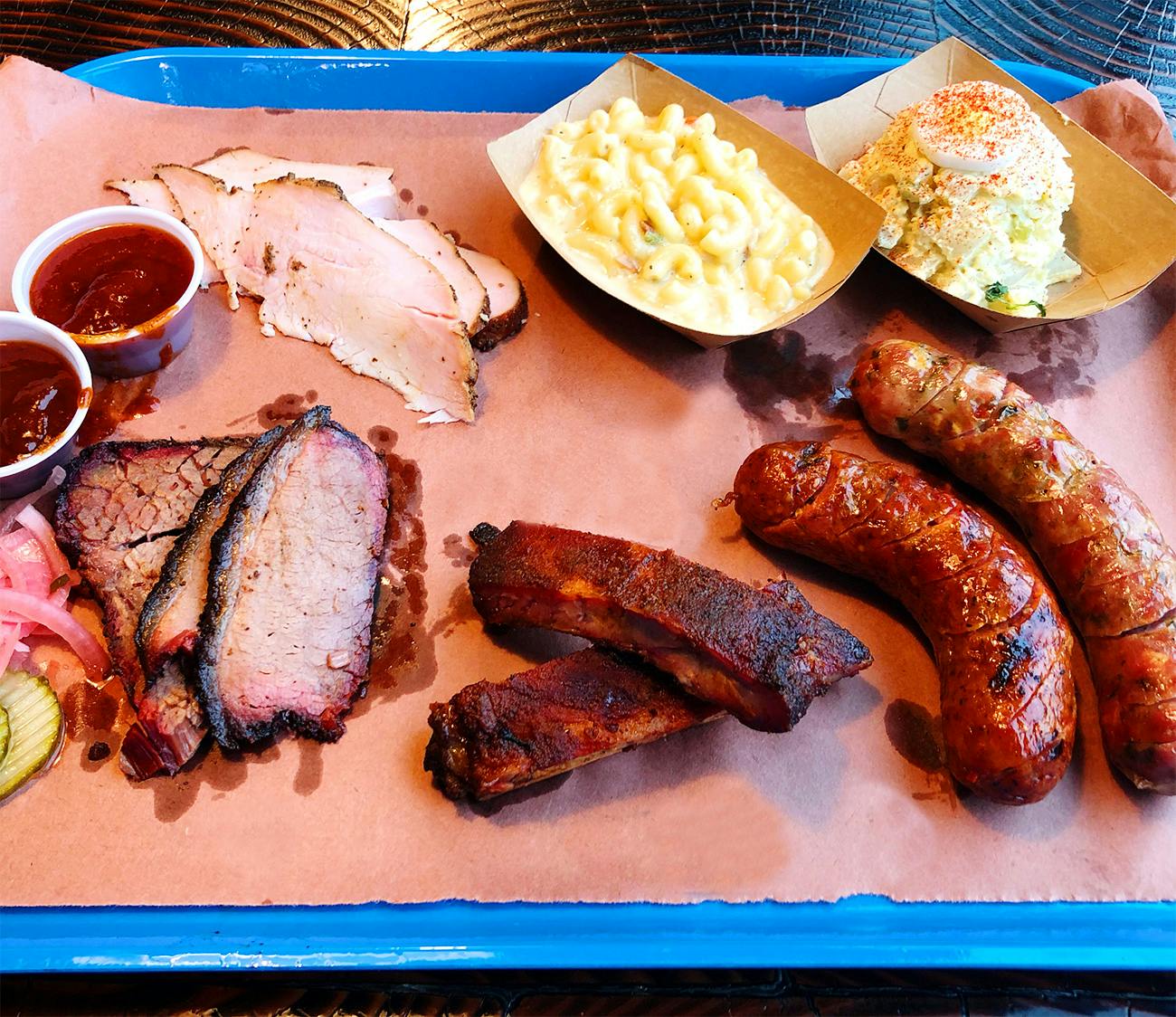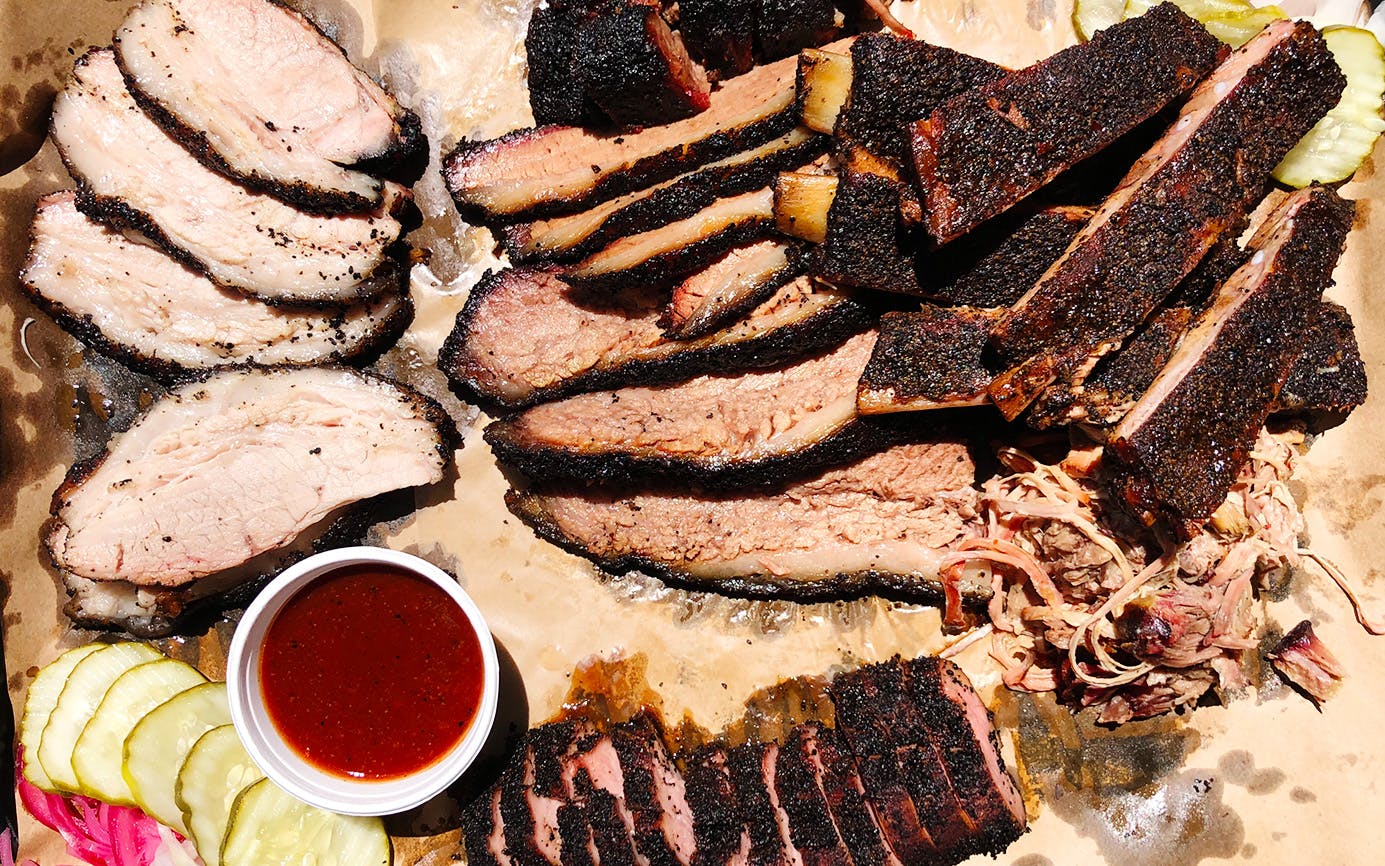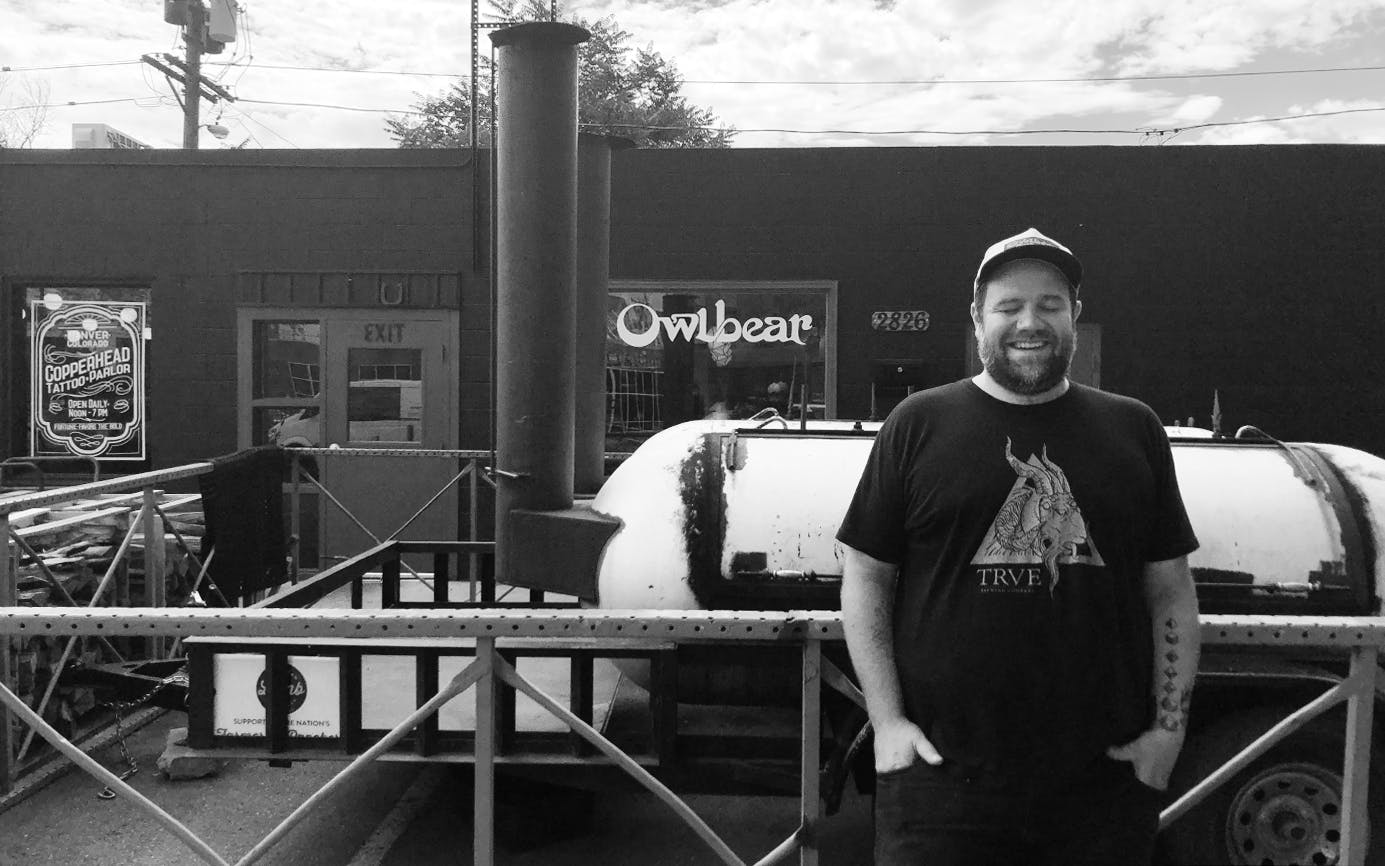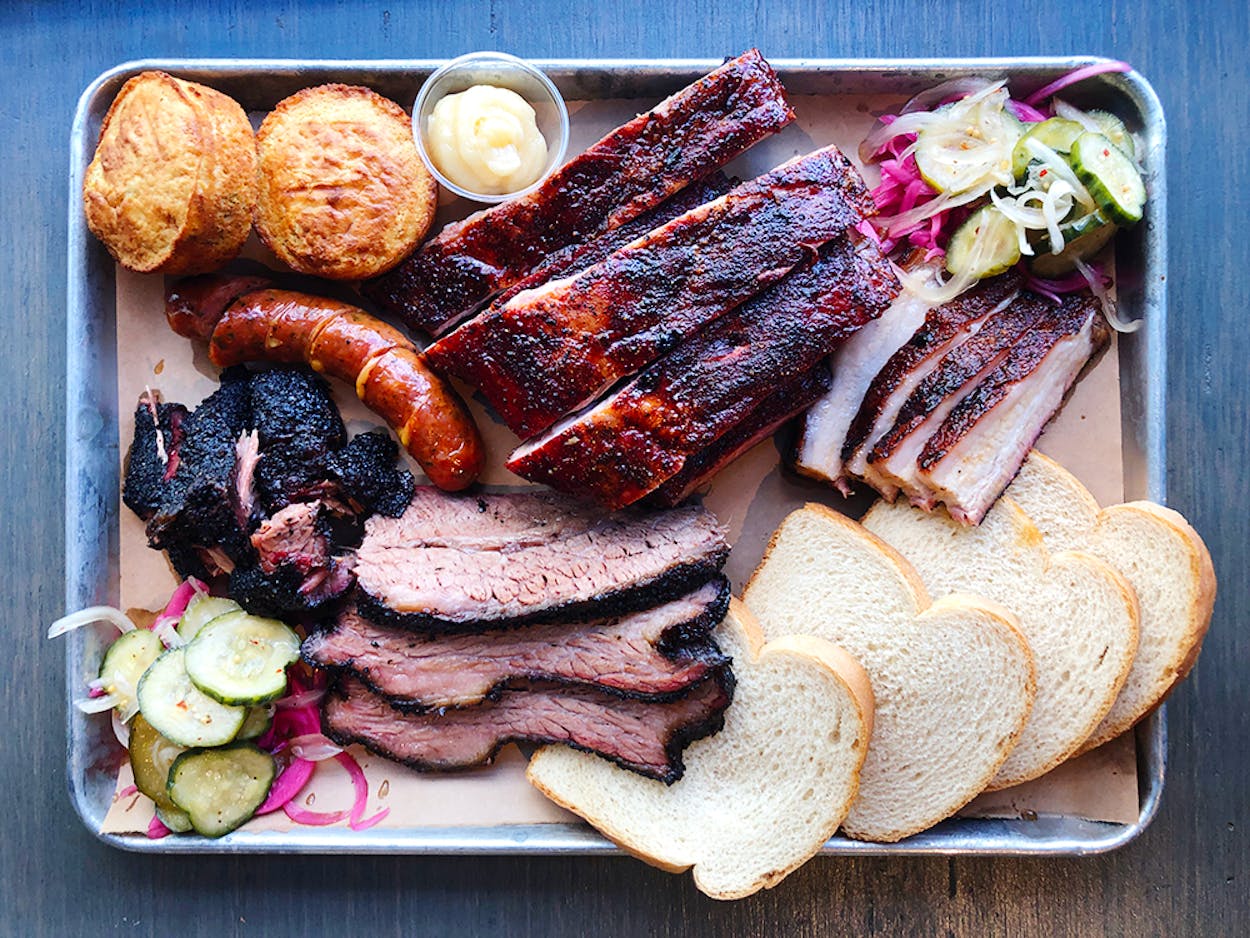Searching for Texas-style barbecue outside the state lines usually means seeking out smoked brisket or maybe beef ribs. In Denver, I found a direct link to Central Texas through a few slices of the far less obvious coffee-rubbed pork tenderloin. Karl Fallenius learned the technique while working at Blue Ox Barbecue, a defunct trailer in Austin where the unique cut was a specialty. Now he smokes it at Owlbear Barbecue, which he opened in the RiNo neighborhood in late May. It doesn’t hurt that Fallenius also learned a few tips on cooking brisket during an eighteen-month stint at Franklin Barbecue before moving to Denver.
Fallenius joins a nascent barbecue scene in Denver where the Texas influence is apparent at places like Hank’s Texas Barbecue in the ruddy spare ribs and monster beef ribs (not to mention the name), and at Wayne’s Smoke Shack, where the Tuesday special is barbecue kolaches. It’s not an easy torch to carry in a city that doesn’t exactly love “transplants,” a derogatory term Denverites apply mainly to Californians and Texans. Adrian Miller, a Denver food writer, friend of mine, and also my local dining companion, said, “People see a Texas license plate or a California license plate, they will shout in the street.” Besides Owlbear, we found a few other Denver joints worth shouting about.

Nick Prince was hoping to recreate a taste of home when he opened Post Oak Barbecue just over a month ago. The Fort Worth native grew up on Railhead’s barbecue, but he didn’t find much that matched it during his nineteen years in the Denver banking industry. “I feel like this town has been about middle-of-the-road, pot-roasty brisket for a long time,” he said. So he started cooking for himself in his own backyard. The hobby turned into an obsession, and, Prince recalls, “I’d be sitting at my desk at the bank googling barbecue stuff.” He halted his career and put everything he and his wife Sandy had into the new barbecue venture. “This is self-funded,” he said. “We’re all in. We burned the ships, so we ain’t going back.”
An Oyler smoker in the back at Post Oak burns the namesake wood. Prince has it shipped from Seguin by the outfit that supplies the Rudy’s Bar-B-Q location in nearby Greeley with the same wood. Sliced brisket and pork ribs were both impressive, but it was the coarsely ground sausages that would have me coming back. The Texas hot link brought more heat than the jalapeño sausage, which traded out the usual cheddar for cotija cheese. You’ll also find barbecue tacos and some excellent fresh-cut fries on the menu, and cold bottles of Shiner are just $2. Any Texan would feel at home.

Coy Webb, who opened Roaming Buffalo Bar-B-Que with his wife Rachael in 2014, also grew up in Texas. He left his family’s cattle ranch outside Plainview for culinary school in Arizona before settling into a fine dining career that spanned four states, the last of them being Colorado. “I knew I wanted to be in Colorado. Texas is too hot. I’m fat, and I don’t like humidity,” he admitted with a laugh. Webb had also had enough of fine dining and wanted to get back to his roots. “My dad always had some sort of burned-out propane tank that we would turn into a smoker,” he remembered. Webb figured he’d do more of the same in Denver, but he didn’t want to simply mimic Texas barbecue.
Webb began researching Colorado’s culinary history. He wondered, “Was there a Colorado barbecue, and how can I recreate that?” Based on his research, there was more to glean from local chuckwagon cooking than pure smoking, but he knew Colorado had plenty of local proteins to feature. Roaming Buffalo’s specialties include bison back ribs, which replaced bison short ribs when the latter got too expensive. They come alongside smoky strands of pulled Colorado lamb shoulder, which Webb insists has a sweeter flavor than lamb from elsewhere. There’s a sausage of local elk made with a recipe inspired by a venison version found in Walter Jetton’s LBJ cookbook. They also serve some great fatty brisket and pork ribs, but this place felt more like a Denver style of barbecue.
A Denver staple with a deeper history than barbecue is green chile. I devoured a pork burrito drenched in the stuff at El Taco de Mexico and wondered why the local barbecue joints hadn’t embraced it as an accompaniment. I knew green chiles and brisket went well together, based on the Chili the Kid sandwich at Mad Jack’s Mountaintop BBQ in New Mexico, so I brought along my own takeout container of green chile to my next barbecue stop.


A pulled pork sandwich at Smōk drenched in that green chile was one of the best barbecue bites I had in Denver. The staff said they’d consider adding the option when Hatch chiles come into season. Then again, their barbecue was plenty good without any sauce. The sweet spare ribs were massive, yet still exhibited the perfect tenderness. The sliced brisket was admirable, as was the house-made jalapeño cheese sausage, even if the latter was too finely ground for my taste. A sandwich of smoked salmon and ginger slaw was a surprise hit at the table.
A group of us tried to pin down the style of barbecue they were trying to achieve at Smōk. It certainly has a big city barbecue vibe, with high prices, vegetarian options, and beautifully arranged trays of smoked meat. We settled on “Texas style + burnt ends,” with the smoked salmon as a wild card. Chef William Espiricueta created the menu, so expect great sides like fried okra and fried green tomatoes, along with stellar cornbread, to come alongside the prettiest barbecue in Denver.

But I didn’t find a better tasting tray of barbecue then the one at Owlbear. What began as a food truck in 2015 had a rough transition into a brick-and-mortar that required two years of construction. A pair of trailer-mounted offset smokers, done by a welder in Denver, sit out front, so there’s no need to wonder where the barbecue is coming from. The source of the meat is just as important to Fallenius. Prime briskets come from Revere Beef, and all the pork comes from local producer Tender Belly. That means the St. Louis ribs aren’t always super-meaty. “We have had a hard time getting really consistent racks if we are avoiding commodity pork products,” Fallenius admitted.
Fallenius credits his time at Franklin Barbecue for his appreciation of the importance of a consistent fire. “I couldn’t believe that someone could control fire like that,” he said, recalling a lesson from Franklin, who showed him how manipulate wood and coals in a firebox to add precisely ten degrees to the smoker temperature. “It was so inspirational to see that it was possible. I thought everyone was almost bullshitting me for a little bit,” he said about the rest of the Franklin crew, who suffered through his early struggles with fire management.

He’s got it figured out now, serving slices of smoked brisket, both from the lean and fatty ends, that were spectacular. It’s not just salt and pepper in the rub. Fallenius adds ground coffee (which goes on all the meats), granulated garlic, granulated onion, and celery seed. Pork ribs get some five spice powder, while the pork shoulder gets a hit of vinegar sauce after being pulled. The coffee is most apparent in the pork tenderloin, which gets only forty minutes on the smoker. Luscious slices of smoked pork belly get the same rub, but several hours of additional cooking time mellow the flavor a bit.
I asked Fallenius, a Colorado native, how he’d describe his style of barbecue. “I think Texas has my favorite technique for smoking meats,” he said, and his choice of smokers backs that up. I enjoyed the variety of flavors from the various rubs found in each cut, but how did five spice powder and a South Carolina vinegar sauce for pork square with Texas-style cooking? Fallenius had a simple answer. “We’re not in Texas.”
- More About:
- Franklin Barbecue








